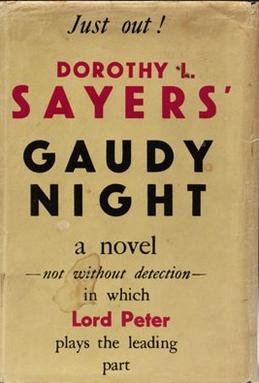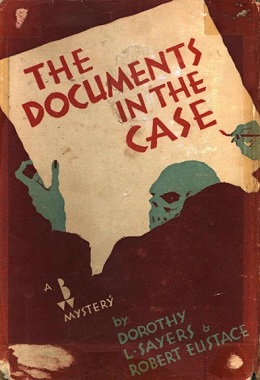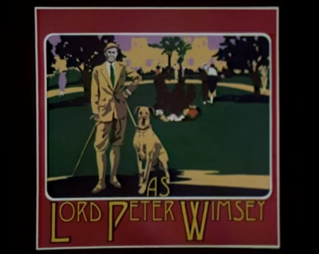
Gaudy Night (1935) is a mystery novel by Dorothy L. Sayers, the tenth featuring Lord Peter Wimsey, and the third including Harriet Vane.
Lord Peter Death Bredon Wimsey is the fictional protagonist in a series of detective novels and short stories by Dorothy L. Sayers. A dilettante who solves mysteries for his own amusement, Wimsey is an archetype for the British gentleman detective. He is often assisted by his valet and former batman, Mervyn Bunter; by his good friend and later brother-in-law, police detective Charles Parker; and, in a few books, by Harriet Vane, who becomes his wife.

Clouds of Witness is a 1926 mystery novel by Dorothy L. Sayers, the second in her series featuring Lord Peter Wimsey. In the United States the novel was first published in 1927 under the title Clouds of Witnesses.

Strong Poison is a 1930 mystery novel by Dorothy L. Sayers, her fifth featuring Lord Peter Wimsey and the first in which Harriet Vane appears.

The Nine Tailors is a 1934 mystery novel by the British writer Dorothy L. Sayers, her ninth featuring Lord Peter Wimsey. The story is set in the Lincolnshire Fens, and revolves around a group of bell-ringers at the local parish church. The book has been described as Sayers' finest literary achievement, although not all critics were convinced by the mode of death, nor by the amount of technical campanology detail included.

Busman's Honeymoon is a 1937 novel by Dorothy L. Sayers, her eleventh and last featuring Lord Peter Wimsey, and her fourth and last to feature Harriet Vane.

Thrones, Dominations is a Lord Peter Wimsey–Harriet Vane murder mystery novel that Dorothy L. Sayers began writing but abandoned, and which remained at her death as fragments and notes. It was completed by Jill Paton Walsh and published in 1998. The title is a quotation from John Milton's Paradise Lost and refers to two categories of angel in the Christian angelic hierarchy.
Harriet Deborah Vane, later Lady Peter Wimsey, is a fictional character in the works of British writer Dorothy L. Sayers (1893–1957).

A Presumption of Death is a 2002 Lord Peter Wimsey–Harriet Vane mystery novel by Jill Paton Walsh, based loosely on The Wimsey Papers by Dorothy L. Sayers. The novel is Walsh's first original Lord Peter Wimsey novel, following Thrones, Dominations, which Sayers left as an unfinished manuscript, and was completed by Walsh. A Presumption of Death is written by Walsh, except for excerpts from The Wimsey Papers.
Mervyn Bunter is a fictional character in Dorothy L. Sayers' novels and short stories featuring Lord Peter Wimsey.

Gillian Honorine Mary Herbert, Baroness Hemingford,, known professionally as Jill Paton Walsh, was an English novelist and children's writer. She may be known best for her Booker Prize-nominated novel Knowledge of Angels and for the Peter Wimsey–Harriet Vane mysteries that continued the work of Dorothy L. Sayers.
In the works of Dorothy L. Sayers, the fictional title of Duke of Denver is held by Gerald Wimsey, older brother of the books' protagonist, Lord Peter Wimsey. In novels written after Sayers' death by Jill Paton Walsh, Lord Peter also eventually holds the title. Sayers and several friends constructed an elaborate backstory for the duchy.

The Documents in the Case is a 1930 novel by Dorothy L. Sayers and Robert Eustace. It is the only one of Sayers's twelve major crime novels not to feature Lord Peter Wimsey, her most famous detective character. However, the forensic analyst Sir James Lubbock, who appears or is mentioned in several of the Wimsey novels, also appears in The Documents in the Case.
Sergeant/Inspector/Chief Inspector Charles Parker is a fictional police detective who appears in several Lord Peter Wimsey stories by Dorothy L. Sayers, and later becomes Lord Peter's brother-in-law.
The gentleman detective, less commonly lady detective, is a type of fictional character. He has long been a staple of crime fiction, particularly in detective novels and short stories set in the United Kingdom in the Golden Age. The heroes of these adventures are typically both gentlemen by conduct and often also members of the British gentry. The literary heroes being in opposition to professional police force detectives from the working classes.

Dorothy Leigh Sayers, known professionally as Dorothy L. Sayers, was an English crime novelist, playwright, translator and critic.
The Wimsey Papers are a series of articles by Dorothy L. Sayers published between November 1939 and January 1940 in The Spectator. They had the form of letters exchanged by members of the Wimsey family and other characters familiar to readers of the Lord Peter Wimsey detective novels; but the articles were intended to convey Sayers's opinions and commentaries on various aspects of public life in the early months of the Second World War.

The Late Scholar is the fourth and final Lord Peter Wimsey-Harriet Vane detective novel written by Jill Paton Walsh. Featuring characters created by Dorothy L. Sayers, it was written with the co-operation and approval of Sayers' estate. It was published by Hodder & Stoughton on 5 December 2013 in the UK, and on 14 January 2014 in North America.

A Dorothy L. Sayers Mystery is a series of television adaptations of three Lord Peter Wimsey novels—Strong Poison, Have his Carcase and Gaudy Night—by Dorothy L. Sayers.

Lord Peter Wimsey is a series of television serial adaptations of five Lord Peter Wimsey novels by Dorothy L. Sayers starring Ian Carmichael broadcast on BBC One between 1972 and 1975, beginning with Clouds of Witness in April 1972.







